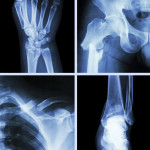If you think bone loss afflicts only brittle older ladies, brace yourself. Study after study confirms that bone thinning may hit one in every two people with HIV—including men and women of all ages. But unlike some other health conditions, this one can bow to effective remedies, many of which benefit your overall health. Jules Levin, HIV-positive advocate and founder of NATAP (the National AIDS Treatment Advocacy Project), has reported on just about every HIV bone study. But until he fractured his wrist in a minor fall last October, Levin, 58, hadn’t realized that his own decades of HIV infection had weakened his infrastructure. “It’s an invisible problem,” says Levin. “Until you break a bone, there are no symptoms.” And despite the stats, monitoring bone health is not yet part of standard HIV care.
Levin leads the cry for more awareness and prevention, and natap.org features a section devoted to bone disease. “The community needs to fight to put this on the map,” Levin says, “to push for routine testing and treatment research like we did with HIV in the first place.” Until that succeeds, here’s help boning up:
Risk factors: Being older, having had HIV longer, having lower weight and being male make bone loss more likely in positive people. Smoking has a “huge [negative] effect” on bones too, says endocrinologist Todd Brown, MD, of Johns Hopkins University, as does alcohol intake greater than three drinks per day.
Measuring tools: Simple X-rays won’t reveal bone strength; you’ll need a DEXA (dual-energy X-ray absorptiometry). This painless scan measures bone mineral density (BMD)—the amount of hard tissue in bones. Results come in a T-score: The more negative the score, the more serious the bone loss (-1.0 or higher is normal; from -1.0 to -2.5 signals osteopenia; less than -2.5 indicates osteoporosis).
DEXA’s price tag (about $200) is as fancy as its name. Generally, insurance covers scans only for postmenopausal women and men over 50 with risk factors. Positive people may get coverage by arguing that HIV is a risk factor.
With or without a scan, you can get stronger bones by taking these steps:
Supplement your diet: First “Feed your bones” (right), then head to the supplement shelf for more calcium and D (phosphorus supplements aren’t usually needed). In general, shoot for 1,200 mg calcium and 800–1,000 IU vitamin D per day.
Bulk up: Along with the right nutrients, exercise is critical. Stronger muscles help support the load on bones, especially for people with low body weight. Weight-bearing exercise has been shown to build bone. It’s recommended for postmenopausal women, and it can work for positive people, too. Walking and aerobics qualify, though weight training is best. Get expert advice, though: Some moves may stress bones that are already weak.
Rx: Positive people with advanced osteoporosis likely need pharmaceuticals along with exercise, diet and supplements. The bone-building drug Fosamax (alendronate, in a class called biophosphonates) so far looks safe for people with HIV. In studies, weekly doses tripled the BMD gains seen with supplements alone, without serious side effects or drug interactions. Newer drugs like denosumab, promising in HIV-negative people, remain to be tested in those with HIV.
And keep raising awareness. Enough community activism might fix this problem before it’s broke.
BREAKING POINTS
Not all bone problems are equal, and it’s important to sort them out so you’ll know which remedies are needed. The one affecting the largest group of positive people is osteopenia (mild bone thinning). Sometimes, osteopenia may worsen into the more dangerous osteoporosis—weakening that leaves bones spongy, brittle and easily broken.
Unrelated to these two and far more rare is osteonecrosis (also called avascular necrosis or AVN), death of bone cells from lack of blood supply, most often striking hips or shoulders. Risk factors include use of corticosteroids (like prednisone), high blood cholesterol and triglycerides, and excessive alcohol use. Current treatments: physical therapy and bone-replacement
surgery.
FEED YOUR BONES
Bones need calcium, phosphorus and vitamin D (D helps bones absorb calcium). Many Americans don’t get enough calcium and D. To make sure you do, eat these:
For calcium: Milk and dairy products, loaded with calcium and phosphorus, are the classic bone-building foods. Lactose-intolerant? Try looking into beans and tofu; many leafy greens (like bok choy and kale) and some fish (salmon and sardines) are also calcium-rich.
For vitamin D: Fish and fish oils, egg yolks and liver are rich in vitamin D. But orange juice and many processed foods are now fortified with calcium and D.
To complete the bone-building agenda, also see on this page “Supplement your diet,” “Bulk up” and, for those with serious bone loss, “Rx.”
THE ROLE OF HIV MEDS
Can HIV treatment itself cause or hasten bone loss? Studies disagree. Protease inhibitors (PIs) and the nuke Viread (tenofovir) have been indicated as possible culprits in bone thinning. But the problem emerged before combo therapy, and there is evidence that HIV itself reduces bone mineral density. Lower nadir (lowest-ever) CD4 counts have been linked to bone thinning, and lower current counts may be, as well. By keeping CD4 counts up, HIV combo therapy may lower the risk of bone loss.
STAT:
- Osteopenia affects about 29% of the general U.S. population—mostly
- Postmenopausal women—and osteoporosis, 1%
- Osteopenia affects 52% of HIV-positive adults—not limited to postmenopausal women—and osteoporosis affects nearly 10%.
Source: The recent SUN Study of 625 HIV-positive adults from four large U.S. cities






3 Comments
3 Comments